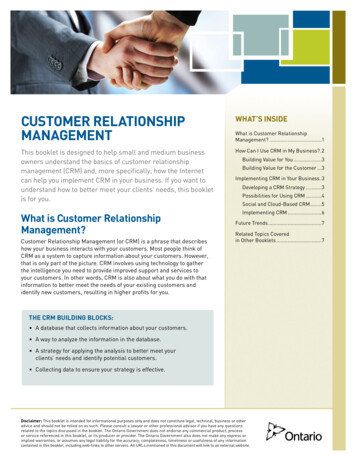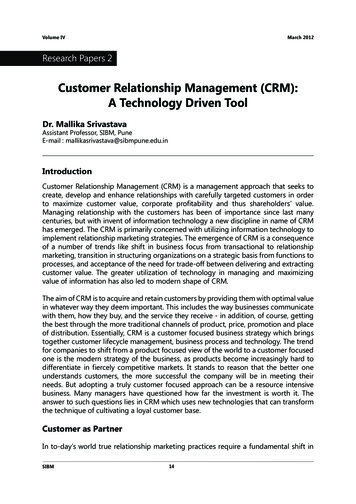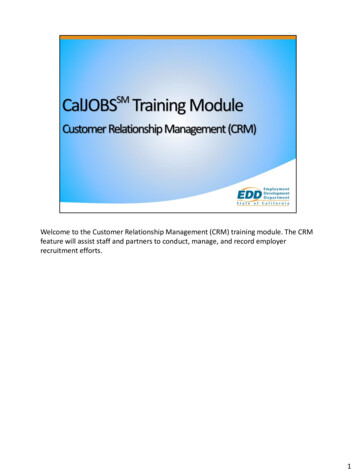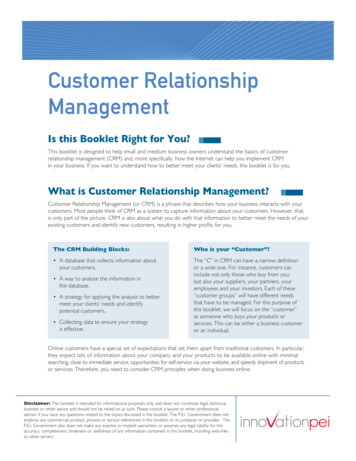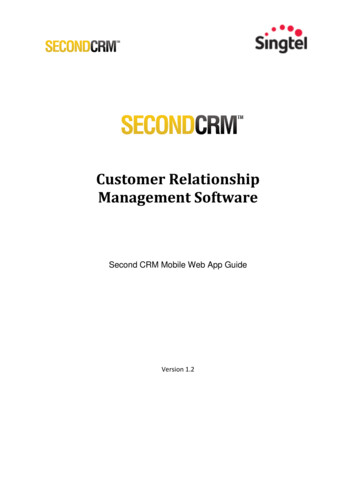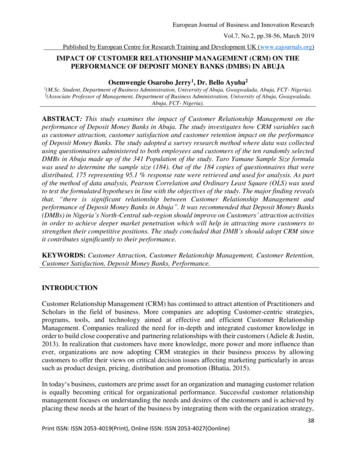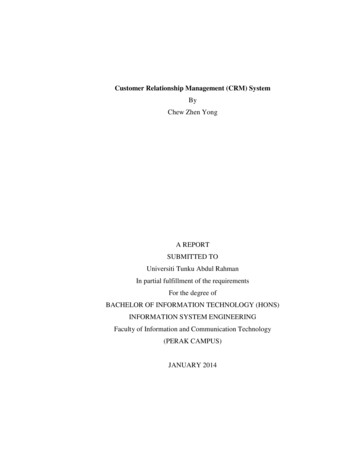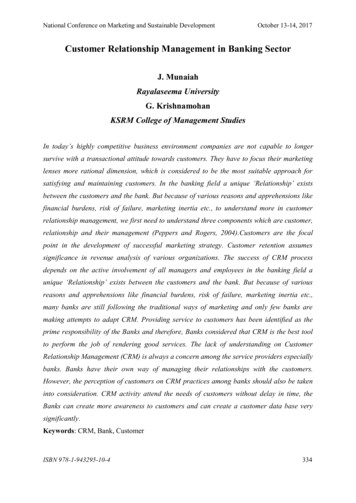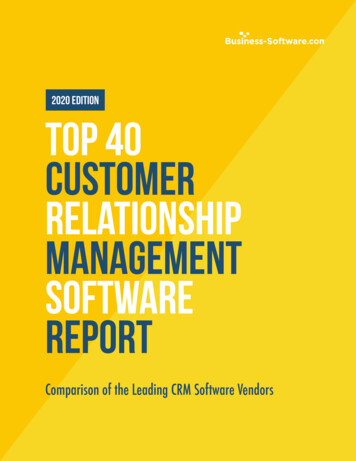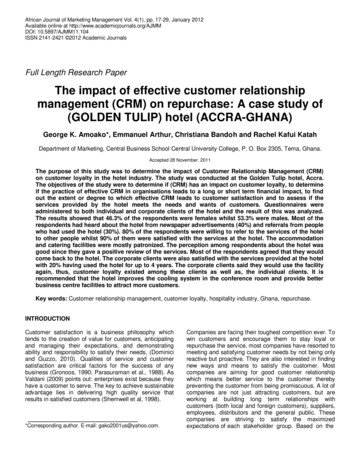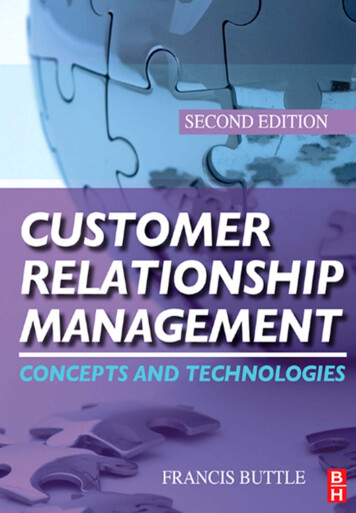
Transcription
Customer Relationship Management
VSFThis book is dedicated to my children Emma and Lewis of whom I amenormously proud.
CustomerRelationshipManagementConcepts and TechnologiesSecond editionFrancis ButtleAMSTERDAM BOSTON HEIDELBERG LONDON NEW YORK OXFORDPARIS SAN DIEGO SAN FRANCISCO SINGAPORE SYDNEY TOKYOButterworth-Heinemann is an imprint of Elsevier
Butterworth-Heinemann is an imprint of ElsevierLinacre House, Jordan Hill, Oxford OX2 8DP30 Corporate Drive, Suite 400, Burlington, MA 01803, USAFirst edition 2009Copyright 2009, Francis ButtlePublished by Elsevier Ltd. All rights reserved.The right of Francis Buttle to be identified as the author of this work has beenasserted in accordance with the Copyright, Designs and Patents Act 1988No part of this publication may be reproduced, stored in a retrieval system, ortransmitted in any form or by any means electronic, mechanical, photocopying,recording or otherwise without the prior written permission of the publisher.Permissions may be sought directly from Elsevier’s Science & Technology RightsDepartment in Oxford, UK: phone ( 44) (0) 1865 843830; fax: ( 44) (0) 1865853333; email: permissions@elsevier.com. Alternatively you can submit yourrequest online by visiting the Elsevier web site at http://elsevier.com/locate/permissions, and selecting Obtaining permission to use Elsevier material.NoticeNo responsibility is assumed by the publisher for any injury and/or damage topersons or property as a matter of products liability, negligence or otherwise,or from any use or operation of any methods, products, instructions or ideascontained in the material herein. Because of rapid advances in the medicalsciences, in particular, independent verification of diagnoses and drug dosagesshould be made.British Library Cataloguing-in-Publication DataA catalogue record for this book is available from the British LibraryLibrary of Congress Cataloging-in-Publication DataA catalog record for this book is available from the Library of CongressISBN: 978-1-85617-522-7For information on all Butterworth-Heinemann publicationsvisit our web site at www.elsevierdirect.comTypeset by Charon Tec Ltd., A Macmillan Company.(www.macmillansolutions.com).Printed and bound in Hungary09 10 11 12 1310 9 8 7 6 5 4 3 2 1
ContentsForewordPrefaceAcknowledgementsAbout the authorxixiiixviixxi1 Introduction to customer relationship managementChapter objectivesIntroductionStrategic CRMOperational CRMAnalytical CRMCollaborative CRMMisunderstandings about CRMDefining CRMCRM constituenciesCommercial contexts of CRMThe not-for-profit contextModels of CRMSummaryReferences1334691112141617181822222 Understanding relationshipsChapter objectivesWhat is a relationship?Relationship qualityWhy companies want relationships with customersWhy companies do NOT want relationships with customersWhy customers want relationships with suppliersWhy customers do NOT want relationships with suppliersCustomer satisfaction, loyalty and business performanceResearching the satisfaction–profit chainRelationship management 53 Planning and implementing customer relationshipmanagement projectsChapter objectivesIntroduction616363
vi ContentsCRM implementationPhase 1: Develop the CRM strategyPhase 2: Build CRM project foundationsPhase 3: Needs specification and partner selectionPhase 4: Project implementationPhase 5: Evaluate performanceSummaryReferences63657280899091914 Developing, managing and using customer-related databasesChapter objectivesIntroductionWhat is a customer-related database?Developing a customer-related databaseSelect the database technology and hardware platformMaintain the databaseDesirable data attributesData integrationData warehousingData martsData access and interrogationData miningPrivacy 21131141171201205 Customer portfolio managementChapter objectivesWhat is a portfolio?Who is the customer?Basic disciplines for CPMMarket segmentationSales forecastingActivity-based costingLifetime value estimationData miningCPM in the business-to-business contextAdditional customer portfolio management toolsStrategically significant customersThe seven core customer management 81411431471541571581601606 Customer relationship management and customerexperienceChapter objectivesIntroductionWhat is meant by customer experience?Experiential marketing strategies and tacticsCustomer experience and the role of CRM163165165165174178
Contents viiFeatures of CRM software applications that influencecustomer experienceResearching the link between customer experience and CRMSummaryReferences1791821831837 Creating value for customersChapter objectivesIntroductionUnderstanding valueSources of customer valueCustomizationValue from productsValue from serviceValue from processesValue from peopleValue from physical evidenceValue from customer communicationValue from 102132142162182192208 Managing the customer lifecycle: customer acquisitionChapter objectivesIntroductionWhat is a new customer?Customer value estimatesProspectingKey performance indicators of customer acquisition programmesMaking the right offerOperational CRM tools that help customer acquisitionSupport from CRM 2502522532539 Managing the customer lifecycle: customer retentionand developmentChapter objectivesIntroductionWhat is customer retention?Manage customer retention or value retention?Economics of customer retentionWhich customers to retain?Strategies for customer retentionPositive customer retention strategiesLearning from research into customer commitmentContext makes a differenceKey performance indicators of customer retention programmesThe role of researchStrategies for customer 283
viii ContentsStrategies for terminating customer relationshipsSummaryReferences28428728710 Managing networks for customer relationshipmanagement performanceChapter objectivesIntroductionWhat is a network?Business networksNetwork positionWhat is meant by ‘focal firm?’Business networks and CRMThe SCOPE of CRMSupplier networksDistribution networksPrinciples of network managementManagement of networksManagement in networksResearch into network 829930030130330330630730730811 Managing supplier and partner relationshipsChapter objectivesIntroductionSupplier relationshipsProduct developmentSupplier accreditation programmesProcess alignmentTrends in supplier relationship managementProduct development alliancesElectronic procurementPartnersPartners in value creationAlliances between non-competing firmsAlliances between competing firmsCategory teamsBenchmarking partnersRegulatorsCustomer advocacy groupsSponsorsPartners in value 2332432732732933033133133333333533634034012 Managing investor and employee relationshipsChapter objectivesIntroductionOwner/investor relationships343345345345
Contents ixEducate current investorsInvestor relations portalsEmployeesInternal marketingEmpowermentThe service–profit chainEmployee relationship management (ERM) 5435535735936013 Information technology for customer relationshipmanagementChapter objectivesIntroductionOrigins of CRM technologyThe CRM ecosystemCRM solutionsCRM analyticsCRM architectureMultichannel CRMMobile and wireless solutionsIntegrationKnowledge managementAutomated 38138338538939039139214 Sales-force automationChapter objectivesIntroductionWhat is SFA?The SFA ecosystemSFA software functionalitySFA adoptionHow SFA changes sales 0840941015 Marketing automationChapter objectivesIntroductionWhat is marketing automation?Benefits of marketing automationSoftware applications for 16 Service automationChapter objectivesIntroduction443445445
x ContentsWhat is customer service?What is service automation?Benefits from service automationSoftware applications for serviceSummaryReferences44544744945046146117 Organizational issues and customer relationshipmanagementChapter objectivesIntroductionOrganizational roles and CRMStrategic goals of CRMConventional customer management structuresNetwork and virtual organizationsPerson-to-person contactsKey account managementTeam 6481482483Index485
ForewordCustomer relationship management’s impact in the commercialmarketplace cannot be undervalued. Despite traditional economic theoryon market entry and pricing prescribing that enterprises should engagecustomers through prefabricated reactions and interactions given thecustomer event taking place, the nature, impact and reach of the powerof enriching customer experiences has emerged in 2008.Yet, one of the most common mistakes made by global companies is toview CRM as solely a technology or business challenge. CRM is first andforemost a business strategy that can be effectively executed through theappropriate business process and technology management capabilitiesthat best match to an organization’s customer-facing goals.Long gone are the views of CRM being applications or businessprocess methodologies for engaging customers in contact centers in thecustomer service functional domains within an organization. Today,every interaction or ‘moment of truth’ with customers can help sustain,direct, implore or resuscitate desired outcomes by enterprises. Theseprocesses transcend functional departmental silos and extend their reachacross the process network to include sales and distribution partners andchannels. Technology, process and organizational architectures togetherin concert will determine the effectiveness of how these end-to-endbusiness processes will align to customer intents and enrich their overallexperience with an organization.The CRM strategic paradigm has gone through a three-phasegenerational shift over the last decade (1998–2008) with enterprisesmaturing from: 1) Marketing to customers the best products at the bestprices, to 2) Marketing customers with the best services, to 3) Marketingcustomers with the dynamic services and products that they want anddesire as measured by customer intent. Today, with the advent andproliferation of social communities across the internet world customershave channels for information-sharing on an enterprise’s services andproducts that is extremely powerful. This emergence has disruptedconventional approaches towards managing customer or productinformation. Paradoxically, customers no longer look towards an enterpriseas the best source of data or information about their own commercialproduct or service offerings. This sense of brand promise and brand trusthas deteriorated, and today customers place their confidence in the sharedand communal experiences of others through social community networkswhich provide transparency on valued customer experiences in themarketplace. In fact, as this book is being printed a great number of CRMApplication vendors in the marketplace are vying to provide technologysolutions for enterprises to integrate and use these social networks as partof core enterprise ERP and CRM solutions.
xii ForewordIt is with distinct pleasure that I introduce you to Francis Buttle’scomprehensive work on CRM. His passion for and grasp of the concepts,disruptors and application of CRM approaches will accelerate readers’abilities to grasp these exciting topics.When considering CRM, there is no strategic alternative for enterprisesbut a relentless approach towards driving customer centricity in order toachieve current, future and lifetime profitability by creating customersfor life.Isher KailaResearch Director, Global CRM StratetyGartner Inc.San Jose, CAUSA
PrefaceWelcome to the second edition of Customer Relationship Management:Concepts and Technologies.The book provides a comprehensive and balanced review of CustomerRelationship Management. It explains what CRM is, the benefits itdelivers, the contexts in which it is used, the technologies that aredeployed, and how it can be implemented. It shows how CRM practicesand technologies are used to enhance the achievement of marketing,sales and service objectives throughout the customer life-cycle stages ofcustomer acquisition, retention and development, whilst simultaneouslysupporting broader organizational goals.The book has been written to meet the demand for an impartial,academically-sound, examination of CRM. It is a learning resource bothfor students of CRM and for managers wanting a better appreciation ofthe role that CRM can play in their own organizations.The first edition was entitled Customer Relationship Management:Concepts and Tools. The change to the new subtitle, Concepts andTechnologies, reflects the requirements of readers. In true customeroriented manner, we surveyed readers and adopters of the first edition.They said they wanted more on CRM technologies. This book deliversit. However, although there are a number of chapters dedicated to CRMtechnologies, and technology matters are considered throughout the book,the book puts technology into a managerial context. This is not a bookabout technologies, but it is about how marketers, salespeople, servicestaff and their managers can use technologies to better understand andmeet the requirements of customers, whilst also meeting organizationalgoals and objectives. Our survey of readers and adopters also discoveredthat they wanted more case illustrations and screenshots from CRMsoftware applications. The book delivers them, too.The book draws on academic and independent research to ensurethat it is both theoretically sound and managerially relevant. Researchfrom a
Trends in supplier relationship management 320 Product development alliances 323 Electronic procurement 324 Partners in value creation 327 Alliances between non-competing fi rms 329 Alliances between competing fi rms 330 Category teams 331 Benchmarking partners 331 Regulators 333 Customer advocacy groups 333 Sponsors 335 Partners in value delivery 336 Summary 340
